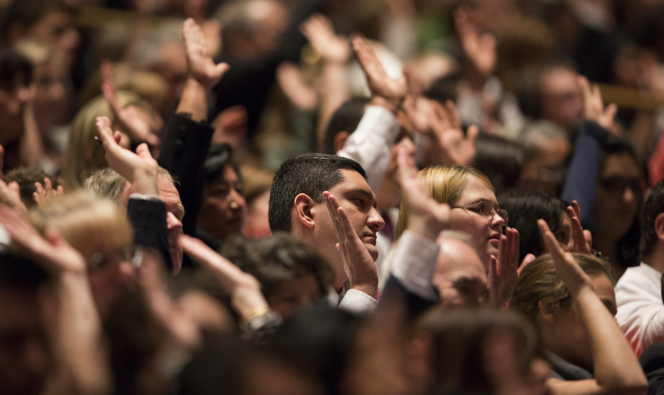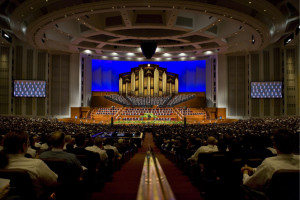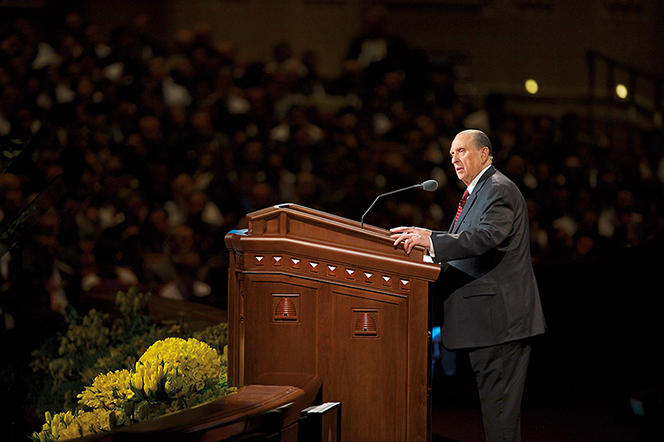The concept of continuing revelation—that God speaks to living prophets and Apostles in our day—is a fundamental doctrine in The Church of Jesus Christ of Latter-day Saints. Perhaps nowhere is this more evident than in the semi-annual general conferences, which take place the first weekend of the months of April and October. During these meetings, the living prophets and Apostles address the worldwide body of The Church of Jesus Christ. Elder Jeffrey R. Holland said:
A general conference of this Church is a remarkable occasion indeed—it is an institutional declaration that the heavens are open, that divine guidance is as real today as it was for the ancient house of Israel, that God our Heavenly Father loves us and speaks His will through a living prophet.
Elder Robert D. Hales said:
Conferences have always been part of the true Church of Jesus Christ. Adam gathered his posterity and prophesied of things to come. Moses gathered the children of Israel and taught them the commandments he had received. The Savior taught multitudes gathered both in the Holy Land and on the American continent. Peter gathered believers in Jerusalem. The first general conference in these latter days was convened just two months after the Church was organized, and conferences have continued to this very day.
These conferences are always under the direction of the Lord, guided by His Spirit. We are not assigned specific topics. Over weeks and months, often through sleepless nights, we wait upon the Lord. Through fasting, praying, studying, and pondering, we learn the message that He wants us to give.
For Latter-day Saints, these worldwide gatherings are unifying, edifying, uplifting and instructional. They are a significant part of the modern Church of Jesus Christ.
Conferences Create Unity

General Conference is available to watch on the Mormon Channel on YouTube and other media platforms.
The Church of Jesus Christ is a global organization with more than 15 million members. General conference is broadcast in more than 90 languages in over 200 countries across the world. Twice a year, Mormons gather as one. It is a heritage that began in the early days of The Church of Jesus Christ. Mormon historian Kenneth W. Godfrey explained:
The first general conference was held in Fayette, New York on 9 June 1830, two months after the Church’s organization. Only seven elders were present; the entire Church had fewer than a dozen priesthood holders. Joseph Smith read the articles and covenants (Doctrine & Covenants 20) which were received by the unanimous voice of the whole congregation. Oliver Cowdery ordained Samuel Smith an elder; then Joseph Smith, Sr., and Hyrum Smith were ordained priests. Thus began the general conference heritage of the Church.
Those early conferences were more like church business meetings. Men were proposed for and sustained in the priesthood. Members of the Church made suggestions and presented resolutions from the floor. Church members were tried, disfellowshipped, excommunicated, chastised, praised, and reinstated.
At first, conferences were convened at the First Presidency’s request at different times of the year and in different places. The 6 April 1833 general conference was held at the ferry on the Big Blue River in Jackson County, Missouri. It was not until Church headquarters moved to Illinois that the pattern was set of holding conferences in each April and October.
Conference took on new meaning after the Latter-day Saints came to the Salt Lake Valley. Godfrey wrote:
After the Saints’ arrival in the Salt Lake Valley, general conference became a time of reunion and spiritual growth. Mission calls often came from the pulpit with no prior warning. … Others were sent to colonize the more than 350 places settled under Brigham Young’s direction…. Such calls added to the excitement of attending a general conference. During those first few years in the Salt Lake valley, fall conference was often held in August or September so that the newly called missionaries could leave before winter storms closed the mountain passes.
But it wasn’t just a time to conduct Church business. The late President Howard W. Hunter said:
Many years have passed since settlers came in covered wagons into this valley in the tops of the Rockies. Conference was an important occasion in their day, and it continues to be a significant occasion in ours as people of faith and devotion come together to renew and strengthen that faith.
It is this spirit of unity, strengthening and faith that continue today. LDS Church President Thomas S. Monson said:
We can’t all be together under one roof, but we now have the ability to partake of the proceedings of this conference through the wonders of television, radio, cable, satellite transmission, and the Internet—even on mobile devices. We come together as one, speaking many languages, living in many lands, but all of one faith and one doctrine and one purpose.
A Time to Sustain the Prophet & Apostles

During the Saturday afternoon session of General Conference, Latter-day Saints have the opportunity to raise their right hands to sustain— or not sustain— the prophet and Apostles of The Church of Jesus Christ. Known as the law of common consent, it is not a democratic vote but rather an opportunity to accept or reject those whom the Lord has called to lead His Church.
General Conference is also a time for Mormons to publicly show their love and support for the Lord’s prophet on the earth today—President Thomas S. Monson—and His Apostles. Living prophets are a hallmark of the Lord’s Church. Elder Russell M. Nelson taught:
A prophet has stood at the head of God’s Church in all dispensations, from Adam to the present day. Prophets testify of Jesus Christ—of His divinity and of His earthly mission and ministry. We honor the Prophet Joseph Smith as the prophet of this last dispensation. And we honor each man who has succeeded him as President of the Church.
In the Saturday afternoon session, each member of The Church of Jesus Christ has the privilege of raising his or her right hand to sustain—or not sustain—those whom Christ has chosen to lead His Church. It is an individual act, but it is also a unifying show of love and support. Elder Nelson explained:
All leaders in the Lord’s Church are called by proper authority. No prophet or any other leader in this Church, for that matter, has ever called himself or herself. No prophet has ever been elected. The Lord made that clear when He said, “Ye have not chosen me, but I have chosen you, and ordained you.” You and I do not “vote” on Church leaders at any level. We do, though, have the privilege of sustaining them. …
Our sustaining of prophets is a personal commitment that we will do our utmost to uphold their prophetic priorities. Our sustaining is an oath-like indication that we recognize their calling as a prophet to be legitimate and binding upon us.
Wherever they are across the globe, Latter-day Saints have the opportunity to sustain the prophet in this meeting. The late Elder David B. Haight said:
In my mind’s eye, I thought of the gatherings of our own family, which is scattered across America—in Georgia; Chapel Hill, North Carolina; Pennsylvania; Texas; California; and here in Salt Lake City. Of those little families in whatever the setting might be, there in their home or in the chapel, I thought I could see some of those little ones being taught to raise their hands and to be in harmony, perhaps their parents teaching them what we were doing. When we raised our hands, we not only just did it in motion because it looks like everybody’s doing it, but because we accept and we’re bearing witness about the knowledge we have and the testimony we have that [then] President Hinckley is our prophet and our leader. We not only raise our hands in saying we sustain but that we follow his direction, that we listen, that we counsel, that we pray about it, that we’re mindful of what comes from the lips of the prophet.
A Time of Instruction
General conference is a time of instruction, when the Lord’s servants speak. President Monson said:
We meet each six months to strengthen one another, to extend encouragement, to provide comfort, to build faith. We are here to learn. Some of you may be seeking answers to questions and challenges you are experiencing in your life. Some are struggling with disappointments or losses. Each can be enlightened and uplifted and comforted as the Spirit of the Lord is felt. …
The messages of General Conference are at once broad and personal—and run the gamut of topics. Elder Holland said:
Most of our congregation … is made up of members of the Church. However, with marvelous new methods of communication, ever larger proportions of the audience for our conferences are not members of the Church—yet. So we must speak to those who know us very well and those who know us not at all. Within the Church alone we must speak to the children, the youth and young adults, the middle-aged, and the elderly. We must speak to families and parents and children at home even as we speak to those who are not married, without children, and perhaps very far from home. In the course of a general conference, we always stress the eternal verities of faith, hope, charity, and Christ crucified even as we speak forthrightly on very specific moral issues of the day. We are commanded in the scriptures to “say nothing but repentance unto this generation,” while at the same time we are to preach “good tidings [to] the meek … [and] bind up the brokenhearted.” Whatever form they take, these conference messages “proclaim liberty to the captives” and declare “the unsearchable riches of Christ.” In the wide variety of sermons given is the assumption that there will be something for everyone. In this regard, I guess President Harold B. Lee put it best years ago when he said that the gospel is “to comfort the afflicted and to afflict the [comfortable].”
But each person who watches can be personally instructed by the power of the Holy Ghost. Elder Hales said:
In conferences we can receive the word of the Lord meant just for us. One member testified: “As I listened to your address, I was astounded. … Your talk was personal revelation directly from the Lord to my family. I have never experienced such a strong manifestation of the Spirit in my life as those minutes when the Holy Ghost spoke directly to me.”
Another said, “I have never before felt so profoundly that a talk was being given to me.”
This is possible because the Holy Ghost carries the word of the Lord unto our hearts in terms we can understand.
And, for Mormons, this is one of the greatest blessings of conference—personal guidance and direction.
A Call to Action
Implicit in the messages of conference is a call to action. Elder Hales said:
The greatest blessings of general conference come to us after the conference is over. Remember the pattern recorded frequently in scripture: we gather to hear the words of the Lord, and we return to our homes to live them.
President Hunter said:
Conference time is a season of spiritual revival when knowledge and testimony are increased and solidified that God lives and blesses those who are faithful. … Conference is the time when our leaders give us inspired direction in the conduct of our lives—a time when souls are stirred and resolutions are made to be better husbands and wives, fathers and mothers, more obedient sons and daughters, better friends and neighbors.
And these messages are available for further study in myriad formats—including online and in the Church magazines following the broadcast. Elder L. Tom Perry said:
Technology has blessed us with many new innovations to spread the message of the gospel through satellite systems, our own network Web site, television, radio, as well as the written text in our magazines and newspaper. All of these add to our delivery systems, which greatly increase our ability to receive the messages that are delivered.
But the bricks and mortar and the continued expansion of technology will only bring the messages to us. One challenge remains the same from the time of King Benjamin [in the Book of Mormon] … to today—that is, the challenge of each individual and family, through personal and collective study, to internalize the messages of the gospel of our Lord and Savior. Salvation is not in facilities or technology, but in the word. Only in the power of the word will it impact our lives and help us to live closer to our Father in Heaven.
The messages of modern prophets, Apostles and other Church leaders are given through inspiration of the Lord. Elder Hales said:
We may not know all the reasons why the prophets and conference speakers address us with certain topics in conference, but the Lord does. [The late] President Harold B. Lee taught: “The only safety we have as members of this church is to … give heed to the words and commandments that the Lord shall give through His prophet. There will be some things that take patience and faith. You may not like what comes from the authority of the Church. It may contradict your [personal] views. It may contradict your social views. It may interfere with some of your social life. But if you listen to these things, as if from the mouth of the Lord Himself, with patience and faith, the promise is that ‘the gates of hell shall not prevail against you; … and the Lord God will disperse the powers of darkness from before you, and cause the heavens to shake for your good, and his name’s glory’ (Doctrine & Covenants 21:6).”
How did President Lee know what we would be facing in our day? He knew because he was a prophet, seer, and revelator. And if we listen and obey the prophets now, including those who will speak in this very conference, we will be strengthened and protected.
What is General Conference?
General conference is a series of two-hour sessions for the general membership of The Church of Jesus Christ of Latter-day Saints. The spring meeting is called annual and the fall meeting semiannual. They are held Saturday and Sunday at 10 a.m. and 2 p.m. mountain time in the 21,000-seat Conference Center in downtown Salt Lake City. Included in the sessions is the general women’s meeting and the priesthood meeting. The general women’s meeting, for girls and women ages 8 and older, is the opening conference meeting and is held on Saturday evening the weekend before General Conference. The priesthood meeting, held Saturday evening between the general Saturday and Sunday sessions, is for young men and men ages 12 and older who have been ordained to the priesthood.
Latter-day Saints travel from all over the world to attend the conference sessions. Free tickets are distributed for each session, but standby lines are also available for those without tickets. Overflow facilities—including the old Tabernacle, the former location for general conference—are located nearby on Temple Square.
Click here to find out how to access the messages of General Conference.


